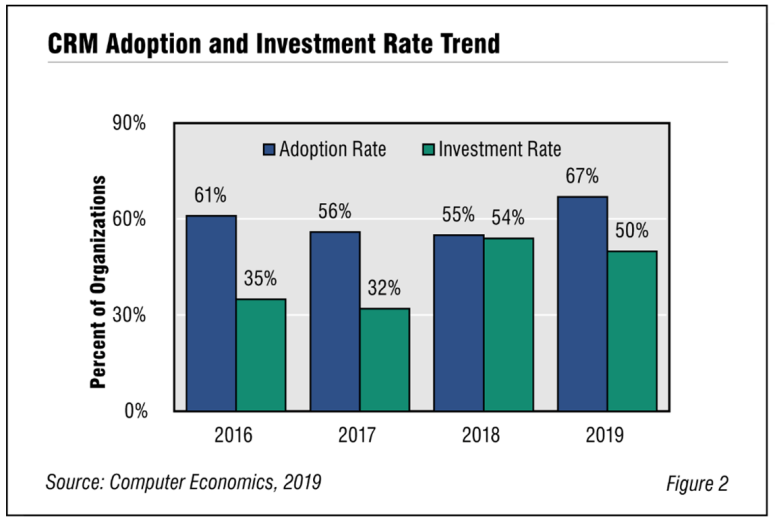Customer relationship management systems have become one of the most popular categories of enterprise applications, and the adoption of these systems has jumped to another level. Worldwide, the CRM adoption rate rose from 55% in 2018 to 67% in 2019. However, overall user-satisfaction rates remain low, compared to other technologies in our study. This Research Byte examines CRM adoption and investment trends based on our full report.
Customer relationship management systems have become one of the most popular categories of enterprise applications, and the adoption of these systems has jumped to another level.
Figure 2 from our full report, CRM Adoption Trends and Customer Experience, shows the adoption rates and investment rates for organizations in our annual survey. The CRM adoption rate rose from 55% in 2018 to 67% in 2019. This is a significant increase, especially for such a mature technology. The majority of all organizations have CRM systems, and investment continues at a healthy pace.

The popularity of CRM is not surprising, as recent iterations of CRM systems provide new capabilities that let companies invest in technology that previously was considered difficult or complex. Machine learning and artificial intelligence (AI) are the most important of these. Most major CRM offerings, including those from Salesforce, Oracle, Microsoft, and IBM (which has a partnership with Salesforce around AI), now include aspects of AI and machine learning baked in, so IT organizations no longer need to build up expertise and infrastructure in these disciplines.
Automation is another area where CRM has changed significantly in recent years. Many CRM systems use AI and big data to help the sales team identify and qualify leads and prospects, recommend potential courses of action, and even compose emails. Machine learning can empower customer self-service portals to put the top solutions in front of customers searching for answers to problems. Automation paired with AI can free up significant time for sales staff to work on the higher-level tasks required to close deals, rather than activities that are purely administrative.
At its heart, a CRM system still must perform the basic tasks always associated with the technology. It must be a source of customer knowledge by centralizing and organizing all information about customers and their previous interactions with the organization. It should help sales professionals find upsell and cross-sell opportunities, achieve better segmentation of customers, and improve the overall customer experience.
CRM does not earn high marks in every category, however.
“The CRM adoption rate is up, but it’s not all sunshine and roses,” said Tom Dunlap, director of research for Computer Economics, a research and consulting firm based in Irvine, Calif. “A large number of users of CRM systems still report being unsatisfied with their systems. It is easy for the deployment to fail to match expectations and deter users from making the best use of the systems.”
The full report provides an overview of key concepts in this space. We also examine CRM adoption and investment trends, providing data on how many organizations have the technology in place, how many are in the process of implementing it, and how many are expanding implementations. We then look at the return on investment experience, total cost of ownership experience, and which type of applications are the most popular. We conclude with recommendations for ensuring the success of CRM implementations and ongoing use.
This Research Byte is a brief overview of our report on this subject, CRM Adoption Trends and Customer Experience. The full report is available at no charge for Avasant Research subscribers, or it may be purchased by non-subscribers directly from our website (click for pricing).

